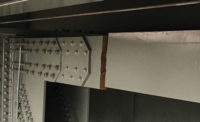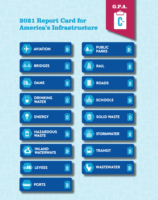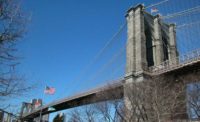The state of the nation’s roads, bridges, water systems and other fixed assets remains poor, according to the American Society of Civil Engineers new infrastructure report card, which shows an overall grade of D+, the same as in ASCE’s last rating, in 2013.
Rail scored the highest grade among infrastructure categories, with a B, thanks to private-sector railroads’ strong capital investment, Greg DiLoreto, chair of ASCE’s committee on America’s infrastructure, said at a March 9 Washington, D.C., event to release the report.
Transit was at the bottom of the group, with a D-minus. DiLoreto said public transit systems have been “chronically underfunded” and have a $90-billion maintenance backlog.
ASCE said that more funding and other investment is a key to raising the scores. It estimated that there is a $2.06-trillion gap, over 10 years, between current infrastructure spending levels and what is needed to pay for upgrades. The 2013 gradebook pegged the shortfall at $1.6 trillion, measured over eight years.
The largest gap is in surface transportation, with an estimated $1.1 trillion—more than half of the total shortfall.
The report calls for increased infrastructure funding from federal, state and local government and the private sector, to 3.5% of Gross Domestic Product by 2025, from 2.5% now.
In a key recommendation, ASCE is calling for a 25¢-per-gallon boost in the federal motor fuels tax, said DiLoreto, retired chief executive officer of the Tualatin Valley Water District in Oregon. Norma Jean Mattei, ASCE’s 2017 president, added that the recommendation also includes indexing the fuels tax for inflation.
Mattei, a professor in University of New Orleans civil and engineering department, referring to the overall infrastructurel investment gap, said, “There’s no magic wand to address this, no infrastructure money tree, no infrastructure private-sector ‘angel.’”
Other transportation grades include D’s for aviation and roads, and C+ scores for bridges and ports.
In the water and environmental sector, dams, drinking water, inland waterways and levees each rated a D; wastewater and hazardous waste both received a D+.
Story changed on March 10 to correct attribution of the comment concerning indexing the motor fuels tax.





Post a comment to this article
Report Abusive Comment